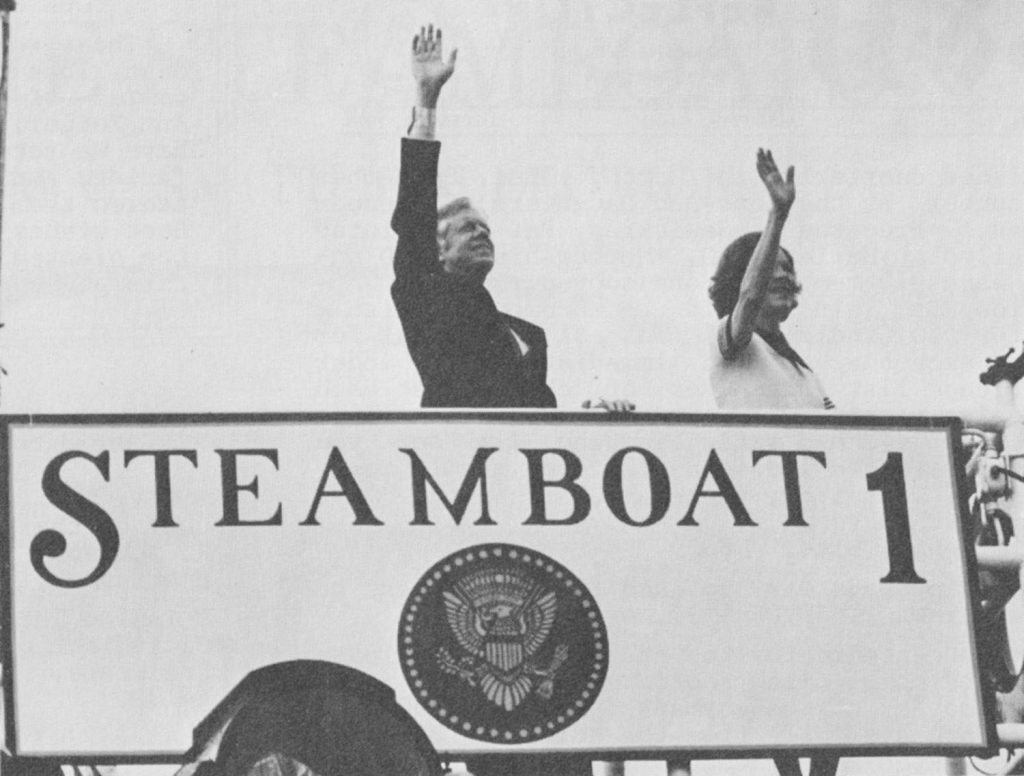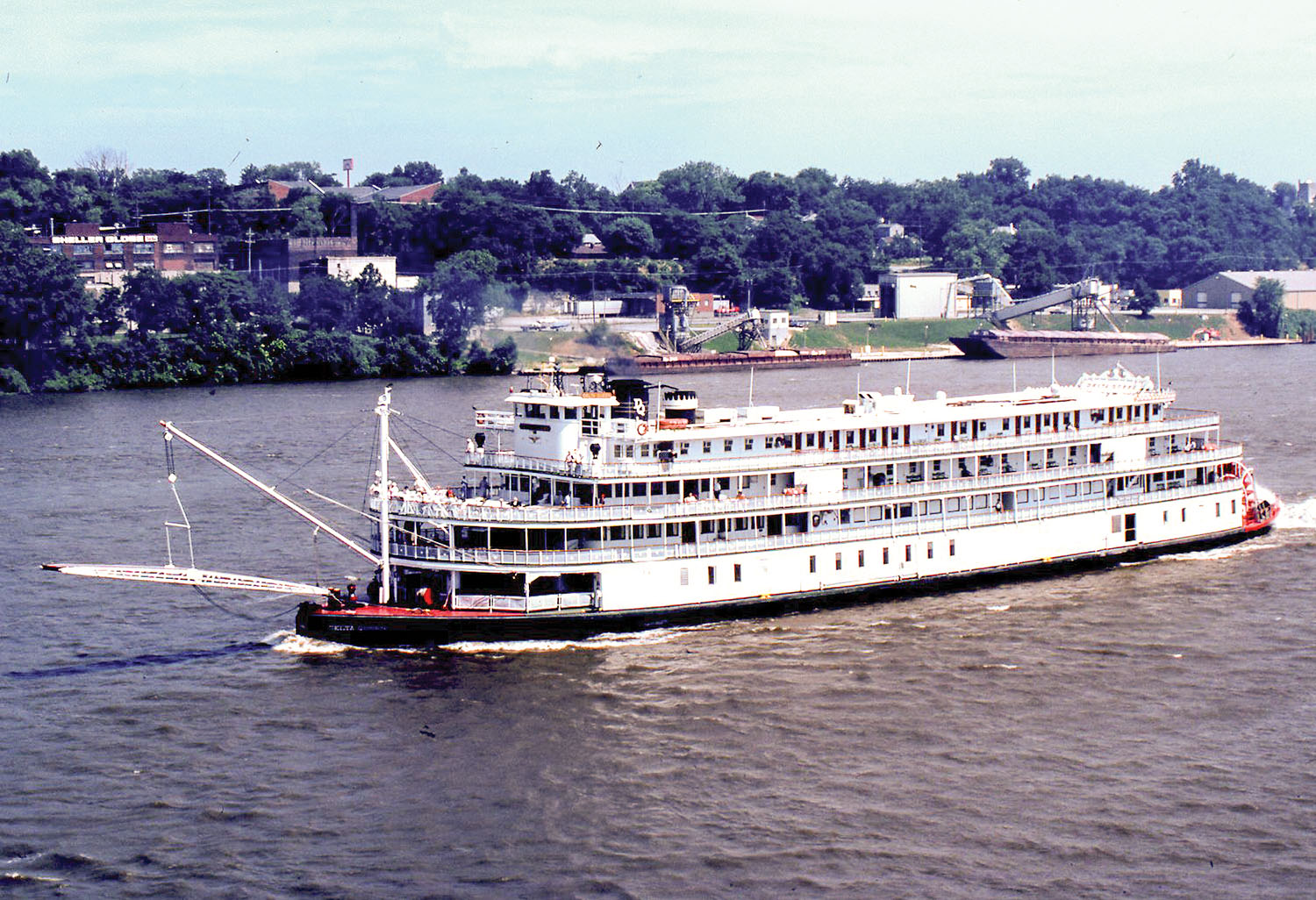The recent passing of former first lady Rosalynn Carter brought to mind the fact that for a brief period in 1979 the overnight passenger steamer Delta Queen bore the unofficial title of “Steamboat 1.”
The Delta Queen has been mentioned within the pages of The Waterways Journal innumerable times since it was constructed in Stockton, Calif., in 1926. It and a duplicate vessel named Delta King originally were designed for service between San Francisco and Sacramento in regular passenger and freight service on the Sacramento River.
According to Capt. Frederick Way, Jr.’s book “The Saga of the Delta Queen,” the steel sternwheel-type hulls of these vessels were fabricated at Glasgow, Scotland, temporarily assembled on the river Clyde, then knocked down and shipped to California.
The final construction was completed at Stockton beginning in 1924 and continuing into 1926. The cabins were completely crafted by local shipbuilders and were of wooden construction containing oak, teak, mahogany and Oregon cedar.
The engines had been built at Denny’s shop in Dumbarton, Scotland, to plans furnished by the Charles H. Evans Company, San Francisco. These engines were cross compound condensing (meaning the steam was first used in a high-pressure cylinder on one side, then through a low-pressure cylinder on the opposite side), 26’s, 52 ½’s with a 10-foot stroke. Two water tube boilers were fired by fuel oil.
The sternwheel had a covering to keep spray off the after portions of the decks.
The two boats had cost an exorbitant $875,000 each (a little over $14.5 million in 2023 dollars) and were owned by the California Transportation Company. The cabins aboard could handle up to 200 passengers, and the boats often carried up to 2,000 tons of freight. They operated in regular service opposite each other until the deepening Great Depression began to impact them. In the mid to late 1930s, River Lines Inc. absorbed the California Transportation Company. and both boats were laid up and eventually sold to Isbrandtsen Steamship Line. This firm had the Delta King boxed up in preparation for transferring it to the Mississippi River when the United States was forced into World War II by the attack on Pearl Harbor.
Both the Delta boats were requisitioned by the U.S. Navy and spent the war years as Yard Ferry Boats, conveying troops to and from ocean vessels in San Francisco Bay.
Following the war, they were turned over to the U.S. Maritime Commission for disposal. The Delta King was auctioned first and went to a Southeast Asia Importing & Exporting Company. The Delta Queen went up for auction on November 20, 1946. Capt. Tom Greene of Greene Line Steamers, Cincinnati, had submitted a losing bid on the Delta King, but his bid on the Delta Queen was the only one received, and the boat went for $46,250.
In a monumental undertaking, the boat was partially encased in rough lumber, then towed by an ocean tug down the West Coast, through the Panama Canal and up through the Gulf of Mexico to New Orleans, a voyage of some 5,400 statute miles.
Capt. Fred Way had overseen the preparation of the boat for the ocean tow, and he again took charge after it arrived at the Avondale Marine Ways at Harvey. La. It was uncrated and steamed on its own from New Orleans to Pittsburgh, where it spent six months at Dravo being transformed into the boat most river people recognize today. The decks of the second and third levels were extended forward to allow a better promenade for passengers, and the covering over the sternwheel was removed at this time.
Capt. Tom Greene tragically died of a heart attack in 1950 at age 46. Greene Line steamers continued to operate the boat until it was sold to a succession of large corporate owners. As it steamed along the inland rivers of the country it became an American icon, and pilots on other boats would perk up when hearing the distinctive radio call letters—WA 4141.

In August 1979, Jimmy Carter, the 39th president of the United States, along with his wife Rosalynn, daughter Amy (and certainly a host of Secret Service and support staff) boarded the Delta Queen at St. Paul and journeyed to St. Louis over the course of a week. Capt. Lexie Palmore, then either a steersman or pilot aboard at the time, and an accomplished artist, stayed up all one night to paint a sign for the steamer. It was complete with the Great Seal and proclaimed to one and all that the vessel was “Steamboat 1.” President Carter was quite pleased with the effort and insisted on being photographed with the artist.
The Safety of Life at Sea Law (SOLAS), originally passed in 1966, put the operation of the Delta Queen at risk due to the wooden construction of the superstructure. Several exemptions tailored specifically for it were passed over the years until they were finally ended in 2008.
Operated at the time by Majestic America Line, the famous boat was leased to interests at Chattanooga, Tenn., and arrived there in February 2009 to become a floating hotel. It was purchased by the newly formed Delta Queen Steamboat Company in early 2015 and departed Chattanooga under tow on March 22 of that year. On April 7, 2015, it arrived at Houma, La., to await a restoration program.
A new congressional exemption was granted the Delta Queen in 2018 that would technically allow it to operate once again. However, at present, the boat remains in the Houma area facing an uncertain future as it awaits the necessary renovations and modifications necessary for that to happen.
Capt. David Smith can be contacted at davidsmith1955obc@gmail.com.




